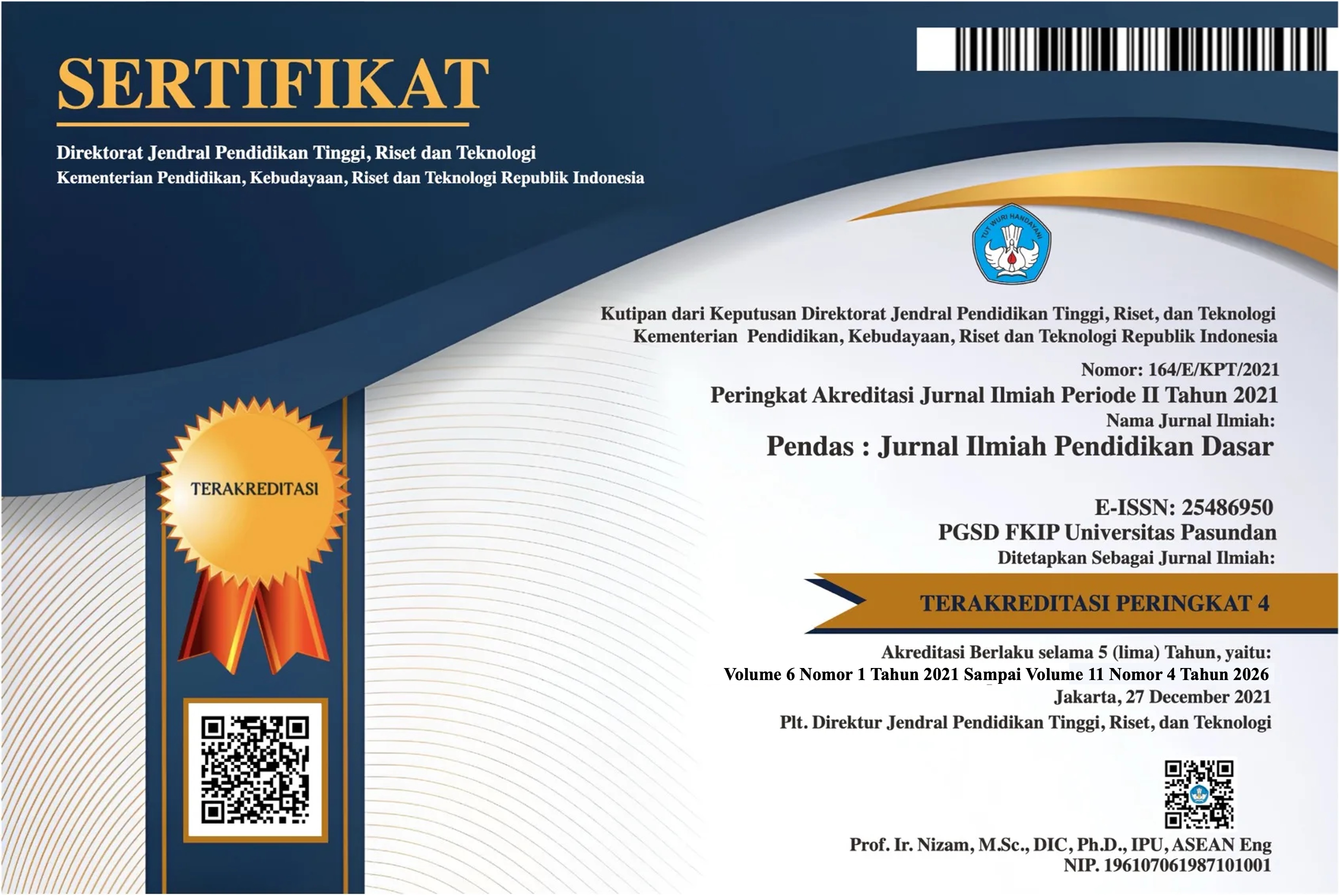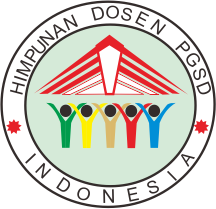SYSTEMATIC LITERAUR REVIEW: MEDIA PEMBELAJARAN AUGMENTED REALITY PADA MUATAN PELAJARAN IPS DI SEKOLAH DASAR
DOI:
https://doi.org/10.23969/jp.v9i03.16060Keywords:
Augmented reality, pembelajaran ips, sekolah dasar, systematic literature reviewAbstract
The importance of innovating to support social studies learning at the elementary school level is very crucial. One form of innovation that can be implemented is through the development of learning media. The use of learning media aims to arouse students' enthusiasm and motivation to learn, which in the end can improve their learning outcomes. This research aims to review literature related to the use of Augmented Reality (AR) media in social studies learning in elementary schools. The research method used is Systematic Literature Review (SLR). Data was collected by documenting and reviewing all articles related to AR published in the 2018-2024 period. A total of 8 accredited national and international journal articles obtained from the Google Scholar database were used in this research. The research results show that AR media can improve learning outcomes, learning motivation, creative thinking abilities, and understanding of concepts in Social Sciences (IPS) learning.
Downloads
References
Al-nawaiseh, S. J. (2020). The Impact of Using Augmented Reality on the Developing the Tenth Graders Motivation Towards Learning: An Applied Study on the Chemistry Courses. European Journal of Business and Management, 12(15), 118–122. https://doi.org/10.7176/ejbm/12-15-13.
Arici, F., Yildirim, P., Caliklar, Ş., & Yilmaz, R. M. (2019). Research trends in the use of augmented reality in science education: Content and bibliometric mapping analysis. Computers and Education, 142(August), 103647. https://doi.org/10.1016/j.compedu.2019.103647.
Bacca, J., Baldiris, S., Fabregat, R., Graf, S., & Kinshuk. (2014). International Forum of Educational Technology & Society Augmented Reality Trends in Education : A Systematic Review of Research and Applications. Educational Technology, 17(4), 133–149. https://www.jstor.org/stable/jeductechsoci.17.4.133
Bistaman, I. N. M., Idrus, S. Z. S., & Rashid, S. A. (2018). The Use of Augmented Reality Technology for Primary School Education in Perlis, Malaysia. Journal of Physics: Conference Series, 1, 1019. https://doi.org/10.1088/1742-6596/1019/1/012064.
Bower, M., Howe, C., McCredie, N., Robinson, A., & Grover, D. (2014). Augmented Reality in education–cases, places and potentials. Educational Media International, 51(1), 1-15. https://doi.org/10.1080/09523987.2014.889400
Caudell, T. P., & Mizell, D. W. (1992). Augmented Reality: An Application of Heads-Up Display Technology to Manual Manufacturing Processes. Proceedings of the Twenty-Fifth Hawai Internasional Comference on System Sciences.
Chen, C. P., & Wang, C. H. (2015). Employing augmented-reality-embedded instruction to disperse the imparities of individual differences in earth science learning. Journal of Science Education and Technology, 24, 835-847. https://doi.org/10.1007/s10956-015-9567-3
Chen, P., Liu, X., Cheng, W., & Huang, R. (2017). A review of using Augmented Reality in Education from 2011 to 2016. 13–19. https://doi.org/10.1007/978- 981-10-2419-1
Del Cerro Velázquez, F., & Méndez, G. M. (2021). Application in augmented reality for learning mathematical functions: A study for the development of spatial intelligence in secondary education students. Mathematics, 9(4), 1–19. https://doi.org/10.3390/math9040369
Garzón, J., Baldiris, S., Gutiérrez, J., & Pavón, J. (2020). How do pedagogical approaches affect the impact of augmented reality on education? A meta-analysis and research synthesis. Educational Research Review, 31, 100334. https://doi.org/10.1016/j.edurev.2020.100334
Hidayat, H., Sukmawarti, S., & Suwanto, S. (2021). The application of augmented reality in elementary school education. Research, Society and Development, 10(3). https://doi.org/10.33448/rsd-v10i3.12823
Janah, I. F. N., Wibisono, R. A., & Subekti, N. (2019, September). Visualizing 3D Objects Using Augmented Reality Application to Enhance Students Retention in Social Science Subject. In 2019 International Seminar on Application for Technology of Information and Communication (iSemantic) (pp. 127-132). IEEE. 10.1109/ISEMANTIC.2019.8884318
Kaleva, S., Pursiainen, J., Hakola, M., Rusanen, J., & Muukkonen, H. (2019). Students’ reasons for STEM choices and the relationship of mathematics choice to university admission. International Journal of STEM Education, 6(1), 43. https://doi.org/10.1186/s40594-019- 0196-x
Kesim, M., & Ozarslan, Y. (2012). Augmented Reality in Education: Current Technologies and the Potential for Education. Procedia - Social and Behavioral Sciences, 47(222), 297–302. https://doi.org/10.1016/j.sbspro.2012.06.654
Kharisma, A. I., MZ, A. S. A., Handoyo, E., & Widiyanti, W. (2023). The “7 Wonders of the World-APP” Augmented Reality-based Media to Improve Elementary School Students’ Conceptual Understanding. Jurnal Ilmiah Sekolah Dasar, 7(1), 18-26. https://doi.org/10.23887/jisd.v7i1.54642
Kusumo, D., & Afandi, R. (2021). The effect of augmented reality learning media on motivation and social studies learning outcomes in elementary schools. Academia Open, 4, 10-21070. https://doi.org/10.21070/acopen.4.2021.2729
Malik, R. S. (2018). Educational Challenges In 21st Century and Sustainable Development. Journal of Sustainable Development Education and Research, 2(1), 9. https://doi.org/10.17509/jsder.v2i1.12266
Martínez, A. A., & García, I. N. (2023). Enhancing social science learning with augmented reality for primary students in a CLIL context. Europub Journal of Education Research, 4(1), 11-33. https://doi.org/10.54745/ejerv4n1-002
McDiarmid, G. W., & Zhao (赵勇), Y. (2022). Time to Rethink: Educating for a Technology Transformed World. ECNU Review of Education, 209653112210764. https://doi.org/10.1177/20965311221076493
Munif, M., Baharun, H., Zamroni, Z., & Fiqiyadatil Ummah, A. H. (2022). Student-Centeredness by Knowledge Sharing: An Effective Learning in Madrasah. AL-ISHLAH: Jurnal Pendidikan, 14(1), 136–146. https://doi.org/10.35445/alishlah.v14i1.1313
Musyaffa, I. F., & Isdaryanti, B. (2024). Pengembangan Media Pembelajaran Aplikasi Kebudayaan Indonesia (Si Budi) Berbasis Augmented Reality Untuk Meningkatkan Hasil Belajar Siswa Kelas IV Sekolah Dasar. Pendas: Jurnal Ilmiah Pendidikan Dasar, 9(2), 2507-2522. https://doi.org/10.23969/jp.v9i2.13351
Novitasari, K. (2019). Penggunaan Teknologi Multimedia Pada Pembelajaran Literasi Anak Usia Dini. Jurnal Golden Age, 3(01), 50. https://doi.org/10.29408/goldenage.v3i01.1435.
Owan, V., & Ekpenyong, J. (2022). Usage of Electronic Infrastructures and Students’ Learning Effectiveness in Nigerian Universities: A Polytomous Logistic Prediction. Ubiquitous Learning: An International Journal, 15(2), 87–104. https://doi.org/10.18848/1835- 9795/CGP/v15i02/87-104
Radu, I. (2012, November). Why should my students use AR? A comparative review of the educational impacts of augmented-reality. In 2012 IEEE International Symposium on Mixed and Augmented Reality (ISMAR) (pp. 313-314). IEEE. 10.1109/ISMAR.2012.6402590
Rahmawati, P. N., & Riyanto, Y. (2023). Pengembangan Media Android Augmented Reality Smart Card (AARSC) Untuk Meningkatkan Keterampilan Berpikir Kreatif Dan Hasil Belajar IPS Peserta Didik Sekolah Dasar. EDUKASIA: Jurnal Pendidikan dan Pembelajaran, 4(1), 687-700. https://doi.org/10.62775/edukasia.v4i1.338
Septian, A., Darhim, & Prabawanto, S. (2020). Mathematical representation ability through geogebraassisted project-based learning models. Journal of Physics: Conference Series, 1657(1). https://doi.org/10.1088/1742-6596/1657/1/012019
Sommerauer, P., & Müller, O. (2014). Augmented reality in informal learning environments: A field experiment in a mathematics exhibition. Computers and Education, 79(2014), 59–68. https://doi.org/10.1016/j.compedu.2014.07.013
Tetep, T., Ismail, A., & Nasrulloh, I. (2023). The Use of Learning Media-Based Augmented Reality (AR) to Improving Integrated Science and Social Studies Literacy. Jurnal Pendidikan Progresif, 13(3), 1267-1275. http://dx.doi.org/10.23960/jpp.v13.i3.202328
Toledo-Morales, P., & Sanchez-garcıa, J. M. (2018). Use of augmented reality in social sciences as educational resource. Turkish Online Journal of Distance Education, 19(3), 38-52. https://doi.org/10.17718/tojde.444635
Triandini, E., Jayanatha, S., Indrawan, A., Putra, G. W., & Iswara, B. (2019). Metode Systematic Literature Review untuk Identifikasi Platform dan Metode Pengembangan Sistem Informasi di Indonesia. IJIS: Indonesian Journal of Information Systems, 1(2), 63–77. https://doi.org/10.24002/ijis.v1i2.1916
Wakid, M., Usman, T., & Sulistyo, B. (2020). Project based learning model to increase the competency of automotive engineering teachers candidates. Journal of Physics: Conference Series, 1700(1), 1–8. https://doi.org/10.1088/1742-6596/1700/1/012063.
Wu, H. K., Lee, S. W. Y., Chang, H. Y., & Liang, J. C. (2013). Current status, opportunities and challenges of augmented reality in education. Computers & education, 62, 41-49. https://doi.org/10.1016/j.compedu.2012.10.024
Yilmaz, R. M., & Goktas, Y. (2017). Using augmented reality technology in storytelling activities: Examining elementary students’ narrative skill and creativity. Virtual Reality, 21(2), 75–89. https://doi.org/10.1007/s10055-016-0300-1
Downloads
Published
Issue
Section
License
Copyright (c) 2024 Pendas : Jurnal Ilmiah Pendidikan Dasar

This work is licensed under a Creative Commons Attribution 4.0 International License.


















